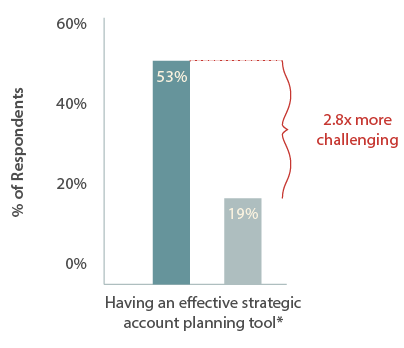Bringing in new customers is expensive. According to research by Fred Reichheld of Bain & Company, it costs 6 to 7x more to acquire a new customer than it does to retain an existing customer.
In our own work, we regularly find companies have significant, untapped opportunities for growing existing accounts.
Yet cross-selling, up-selling, and growing accounts is a major challenge for many companies.
In our research, The Benchmark Report on Top Performance in Strategic Account Management, we looked at what high performers in strategic account management do differently than the rest to grow accounts. These 5 keys show the starkest difference and have the greatest impact on cross-selling success.
5 Steps to Cross-selling Success
1. Value: The Key of all Keys
If buyers value you and your offerings, they’ll buy, keep buying, and be open to expanding your relationship. High performers are much more effective in:
- Their internal process for expanding value to accounts: They uncover buyers’ needs and drive demand for existing company offerings.
- Their process for co-creating value with customers: They work collaboratively with the client to construct new ways of delivering value.
Those who succeed with cross-selling the most know the value they provide, know what the customer values most, and is able to create opportunities to connect the two.
2. Develop Strong Relationships
Growing accounts requires:
- Strengthening and deepening existing relationships
- Establishing new relationships in other buying centers and at enterprise levels
- Viewing relationships as “our company to their organization” as much as you do “myself to my client.”
Those who succeed with account growth develop deep relationships with their customers. They’re viewed as essential, trusted partners.
3. Assemble the Right Team
High performers are much more likely to cite “creating team-based approaches” as effective for growing accounts. There are 6 roles that must be played when growing accounts. The key: one person doesn’t have to do everything, but everything that needs to get done must get done by someone.
At least one person on your account management team must represent each of the following essential roles:
The Big 3:
- Relationship Lead – Creates/strengthens relationships
- Entrepreneur – Drives strategic account growth
- Innovator – Conceives new ways to deliver value
Rounding out the rest:
- Collaborator – Internal team-builder
- Technical Expert – Specialist / analyst / technician
- Researcher – Finds critical info for increasing account value
- Project Manager – Keeps team organized and on track
- Skeptic – Plays devil’s advocate to vet new ideas
4. Utilize Account Management Processes and Planning Tools
Having an effective strategic account planning tool (below) and process is significantly more challenging for average/below average performers:
  |
High performers know the value of having a systematic process to follow and have the tools in place to support that process.
5. Develop both Account Management Skills and Sales Skills
Both account management skills and sales skills are necessary for cross-selling success. Without strong sales skills, you can’t leverage your account planning process or tools because implementation falters.
Many attempts at sales training do not result in sales skills. The training itself has to work to develop the needed skills, knowledge, and attributes.
If you’re looking to increase cross-selling success at your organization, think about how you stack up in each of these areas. And for more information on how to implement each of these keys, download our report, 5 Keys to Maximizing Sales with Existing Accounts.






